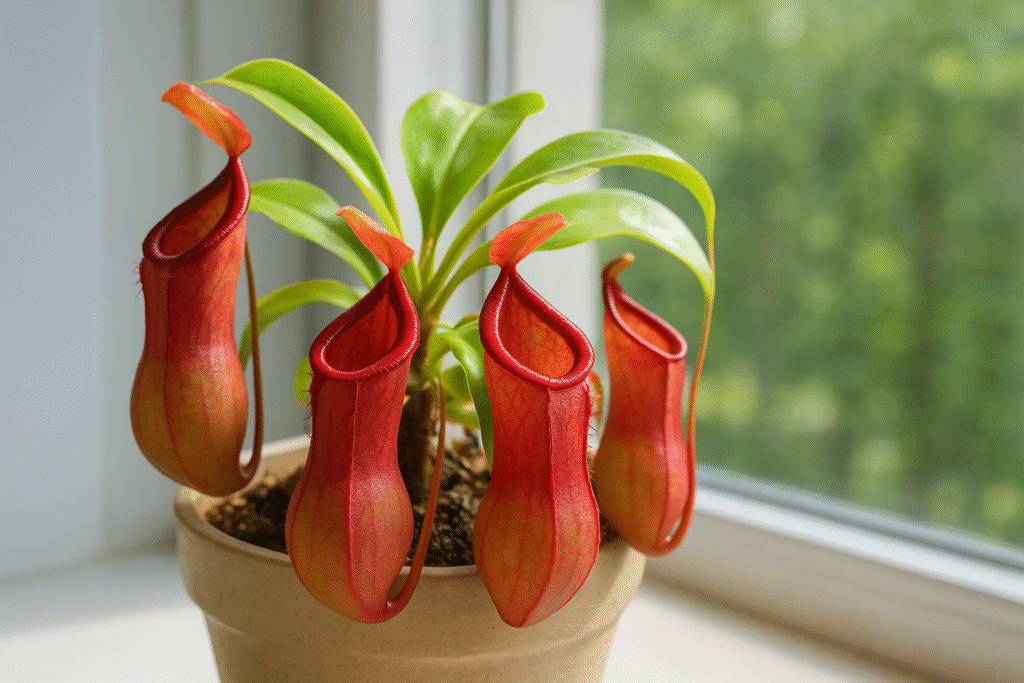The Pitcher Plant is one of nature’s most extraordinary creations. Known for its distinctive pitcher-shaped leaves that trap and digest insects, this carnivorous plant thrives in tropical and subtropical regions across the globe. Pitcher plants are not only captivating to look at but also fascinating examples of natural adaptation and survival.
These unique plants grow in nutrient-poor soil, which led them to evolve a remarkable feeding mechanism — they capture and digest insects to obtain the nutrients they can’t get from the ground. From the rainforests of Borneo to North America’s wetlands, the pitcher plant stands as a true wonder of the natural world.
Understanding the Pitcher Plant
Pitcher plants belong to several genera, including Nepenthes, Sarracenia, Cephalotus, and Heliamphora. Though they come from different regions, all share the same core characteristic — modified leaves shaped like a “pitcher” that act as insect traps.
How Does a Pitcher Plant Catch Insects?
The plant’s pitchers are filled with digestive fluids that break down prey into nutrients. The rim of the pitcher is slippery and often brightly colored to lure insects. Once an insect slips inside, tiny downward-pointing hairs prevent escape, and the digestive enzymes take over.
This process allows the plant to absorb essential nutrients like nitrogen and phosphorus — vital for its growth in poor soil conditions.
Types of Pitcher Plants
There are over 150 known species of pitcher plants, each with its own unique beauty. Here are some of the most common types:
1. Nepenthes (Tropical Pitcher Plant)
Native to Southeast Asia, Nepenthes are climbing plants with hanging pitchers. They thrive in humid conditions and are often grown as exotic houseplants.
2. Sarracenia (North American Pitcher Plant)
These species grow in the wetlands of the United States and are known for their upright, tubular pitchers and colorful veins.
3. Cephalotus follicularis (Australian Pitcher Plant)
Also known as the Albany Pitcher Plant, this small but striking species is native to southwestern Australia.
4. Heliamphora (Sun Pitcher Plant)
Found in South America, especially in the highlands of Venezuela and Brazil, these plants prefer cool and humid environments.
Ideal Growing Conditions for Pitcher Plants
Pitcher plants require specific conditions to thrive. Replicating their natural environment at home ensures healthy growth and beautiful pitchers.

Light Requirements
Pitcher plants love bright light but not harsh direct sun (especially tropical varieties).
- Indoors: Place near a bright window with filtered light.
- Outdoors: Give 4–6 hours of morning sunlight.
Temperature and Humidity
Most species prefer warm and humid conditions.
- Optimal temperature: 70–85°F (21–29°C)
- Humidity: Around 50–70% for healthy pitchers
Mist your plant regularly or use a humidity tray if the air is too dry.
Watering and Soil Care
Watering is one of the most important factors in caring for a pitcher plant.
Watering Tips
- Always use distilled water or rainwater — tap water can harm the plant due to minerals.
- Keep the soil moist but not waterlogged.
- Do not let the plant dry out completely.
Soil Requirements
Pitcher plants prefer nutrient-poor, acidic soil. Use a mix of sphagnum moss and perlite or a ready-made carnivorous plant soil mix. Avoid fertilizers — the plant gets nutrients from captured insects.
Feeding and Nutrition
Since pitcher plants are carnivorous, they get most of their nutrients by digesting insects like flies, ants, and mosquitoes.
Feeding Indoors
If your plant is grown indoors and can’t catch bugs naturally, feed it a few small insects once or twice a month. Avoid overfeeding — a single bug every couple of weeks is enough.
What Not to Feed
Never feed your pitcher plant meat or human food — it will rot inside the pitcher and harm the plant.
Repotting and Maintenance
Repotting helps keep the plant healthy and prevents root rot.
When to Repot: Every 1–2 years, ideally in spring.
Steps:
- Gently remove the plant from its pot.
- Trim any dead roots or leaves.
- Replant in fresh carnivorous soil mix.
- Water with distilled water to settle the soil.
Trim old, dried pitchers to encourage new growth and maintain a neat appearance.
Propagation Methods
Propagating pitcher plants is a rewarding way to expand your collection.
By Stem Cuttings (for Nepenthes)
- Cut a healthy stem with at least two nodes.
- Place it in moist sphagnum moss.
- Keep it humid and warm until roots form.
By Division (for Sarracenia)
- Divide the root rhizome into sections.
- Replant each section separately in a new pot.
- Water thoroughly.
Propagation success depends on humidity and proper lighting.
Common Problems and Solutions
Even though pitcher plants are hardy, they can face some challenges:
1. Brown Pitchers: Often caused by low humidity or poor water quality. Increase humidity and use distilled water.
2. No Pitchers Forming: The plant may not be getting enough sunlight. Move it to a brighter spot.
3. Mold Growth: Reduce watering slightly and improve air circulation.
4. Weak Growth: Could be due to poor lighting or overfertilization.

Benefits and Interesting Facts
Pitcher plants aren’t just beautiful — they’re scientifically fascinating and environmentally beneficial.
1. Natural Pest Control: They help reduce indoor insect populations naturally.
2. Educational Value: Perfect for classrooms and science enthusiasts studying plant adaptation.
3. Air Purification: Like many plants, pitcher plants help purify the air.
4. Symbol of Adaptation: Represents survival and ingenuity in nature.
Fun Facts About Pitcher Plants
- The digestive liquid inside the pitcher smells sweet to attract insects.
- Some large Nepenthes species can even trap small frogs or lizards!
- The inner surface of the pitcher is ultra-slippery, making escape impossible.
- Scientists study pitcher plants to design better non-stick surfaces and trap mechanisms.
FAQs About Pitcher Plants
Q1: Are pitcher plants hard to grow?
Not really! They just need humidity, bright light, and clean water — once set up, they’re quite easy to maintain.
Q2: Can I grow pitcher plants indoors?
Yes, as long as they get enough light and humidity. A bright window or a grow light setup works great.
Q3: Do I have to feed my pitcher plant bugs?
Only if it’s indoors and can’t catch insects naturally. A few small bugs monthly are enough.
Q4: Why is my pitcher turning brown?
That’s normal aging, but persistent browning may mean low humidity or poor water quality.
Q5: Are pitcher plants toxic to pets?
No, pitcher plants are generally non-toxic to cats and dogs. However, avoid letting pets chew on them.
Final Thoughts
The Pitcher Plant is a true marvel of evolution — a plant that has adapted to survive where others can’t. Its beauty, unique insect-catching abilities, and easy care make it a favorite for plant lovers and collectors.
By following the simple care tips in this guide, you can enjoy this exotic carnivorous plant right at home — bringing a touch of tropical mystery and natural science to your indoor garden.

